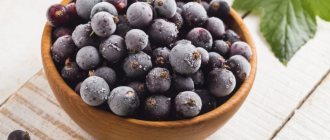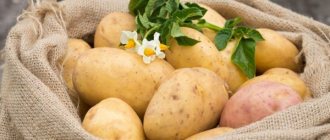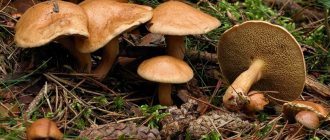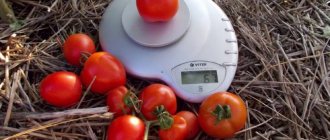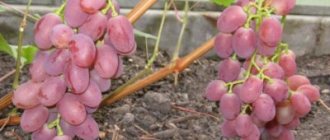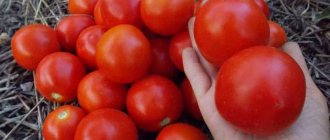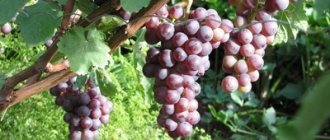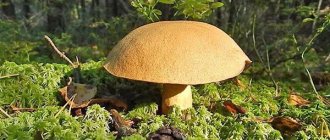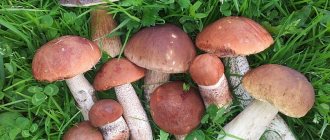Edible boletus mushrooms: what do they look like, what can they be confused with?
Butterflies have several doubles, with which they can easily be confused. At the beginning of summer, that is, in the first days of July, you can find the first wave of butterflies hiding in pine forests. At the same time, false boletus and their doubles appear, which are very similar in appearance. But there are several differences between false and true boletus. There are several types of butter. That is why the mushroom can be seen at the beginning of summer and collected at the very end of autumn.
Differences between boletus and mushroom counterparts:
- False mushrooms have a purple film and a lamellar cap on the inside. A true mushroom has a thin film on the inside of the cap, which, when removed, reveals a porous structure; there are no plates there.
- At the cut site, false boletus secretes liquid, so after a while you will see yellowing. Such a mushroom should be immediately thrown out of the basket. False butterflies are not deadly mushrooms, but eating them can cause indigestion.
- In addition, they taste bitter and can spoil the main dish. Another doppelgänger of the oiler is the panther fly agaric. The difference between these mushrooms is that the poisonous counterpart has whitish spots. That is why the mushroom got its name. Reminds me of the color of a panther.
- But when you collect boletus, leaves or blades of grass may touch the cap. After removing the debris, light spots appear. Therefore, try to collect mushrooms that have no grass or leaves on top, and whose caps are clean.
Butter
Edible counterparts of the grainy butter dish and their differences
The granular species has counterparts in nature. They are edible and differ from each other in appearance.
- Late or ordinary is the most common variety. Prefers to grow among coniferous trees, in sandy meadows and along the road. The hat is up to 10 cm in diameter, hemispherical and flat in shape. The red-brown cap is shiny, covered with a slimy film that is easily removed for cleaning. The tubular layer is covered by a dense film, which, as the mushroom ages, turns into a ring and descends to the stem.
- Red oiler - the mushroom has a small height, a dense fibrous stalk and a red-red cap with a shiny, slimy surface. Prefers to grow under larch and other conifers. The time to collect red butterflies coincides with the flowering of pine trees. The second layer appears simultaneously with the linden flowers. It grows in groups, so harvesting is quick and convenient.
- Cedar - prefers to grow next to five-coniferous pine. The hat with a diameter of 10 cm is painted burgundy. In rainy weather it becomes covered with mucus, and when dry it becomes waxy and fibrous. The pulp is fleshy, with a fruity-almond aroma and a sour taste. This species is often found in Siberia and the Far East, in coniferous and cedar groves.
- The unringed type has a light lemon cylindrical stem and a hemispherical red-brown cap with a diameter of up to 12 cm. The light yellow flesh is dense, fleshy, fibrous, and does not change color when cut. The unringed species has a pleasant taste and smell; overgrown specimens have an unexpressed taste and an unpleasant, sour smell.
Boletus mushrooms - edible: varieties, description, photo
Varieties of butter:
Leaf oiler. They have light gray or brownish flesh and a cap. The top is covered with a mucous coating. The leg has a characteristic ring, the flesh is porous, gray or white. Can be found in mixed forests in September and October.
Leaf oiler
The yellow-brown butterdish differs from the ordinary one in its color. The color is yellow, sometimes orange. If you break the cap, you will see the flesh of the same orange color. The stem has a characteristic ring. At the cut site it sometimes turns purple.
Yellow-brown oiler
Grainy boletus . Early species of mushrooms that can be found in coniferous forests in summer. The color is more faded than that of brown butterflies. At the same time, pores of different sizes are visible on the inside of the cap. Because of this, the oiler got its name.
Grainy boletus
Spring butter dish. It grows in young deciduous forests, as well as on sunny edges. Its surface is slightly sticky, the cap is yellow-brown in color. On the back of the cap there are pronounced pores that darken when pressed. This mushroom can be found in forests from early June to mid-September.
Spring boletus
White boletus has a light cap. In dry weather it is almost gray-white. After rain it turns olive. Mature mushrooms have a cap that is not dome-shaped, but almost flat. On mature mushrooms, gray or brown warts often appear in the cap area. When trying to remove the mucous membrane, it is easily removed.
White boletus
Are there false butterflies?
In fact, there is no such species as “false butterdish” in the botanical classification. However, this is usually the name given to those mushrooms that can easily be mistaken for the most popular types of edible boletus in Russian forests (common, granular, larch). Some of these “doubles” are conditionally edible, or there is no clear opinion about the possibility of their consumption. Several more types can be eaten without fear, but their taste and aroma leave much to be desired.
It is worth dwelling in more detail on what these false boletus are called and what they look like, as well as their photos and descriptions.
Important! If the so-called “doubles” of butter are considered conditionally edible, then, as a rule, their preparation has its own characteristics. This should not be taken lightly: the consequences of improper cooking can be very unpleasant, even leading to serious intestinal upset.
What mushrooms are similar to boletus
Among the mushrooms similar to the common boletus, you can most often encounter the following:
- The oiler is yellow-brown. Edible, but not very tasty mushroom. It has a semicircular cap with a diameter of 5-14 cm, its edges are folded downwards. The color is gray-yellow or gray-orange. With age it turns red, then becomes light ocher. The pores under the cap are small, gray-yellow or brown-olive in color. The length of the leg is 3-9 cm, it is smooth, thick (up to 3.5 cm in girth), usually lemon-yellow in color.
- Siberian butterdish. Information about him differs. According to one version, this false butter dish is inedible, but not poisonous; according to another, it is edible, but does not have much nutritional value due to the acidity and bitterness in taste. Its cap is 4-10 cm in diameter, light or dark yellow, covered with numerous reddish scales. In a young mushroom it resembles a pillow; in an older one it takes on a convex shape, often with edges curved upward and a tubercle in the middle. The skin on it is mucous and can be easily removed. The leg is from 0.5 to 2 cm thick and about 5-7 cm long, yellow in color with brown spots, not hollow inside. The stalk has a fibrous ring that disappears over time.
- Dry oiler, or goat. Edible, but bitter in taste and has almost no aroma. The diameter of the cap is 3-9 cm, it is yellow-brown, ocher or brown in color. In young mushrooms it is solid, convex; in those that are older, it becomes flatter and cracks. The surface of the cap is slimy in rainy weather and matte, velvety when dry. The pores are large and irregular in shape. The thickness of the leg is small (1-2 cm), length - 3-11 cm. It is hollow and curved in shape. At the fracture site, the flesh of the stem turns blue, and the cap turns pink.
- Pepper moss (pepper moss). According to some sources, this double of the common oiler is inedible, according to others it is classified as conditionally edible. So named because of the sharp, pungent taste of the pulp. The cap is 2-8 cm in diameter, copper-red or “rusty” in color, convex, round in shape. The length of the leg is 3-8 cm, thin (up to 1.5 cm), solid, and can be bent. The pores are uneven, wide, matching the cap, but when pressed they acquire a dark brown color.
- Spruce weevil, or slug. Conditionally edible. The fleshy cap, 4-10 cm in diameter, in young mushrooms has the shape of a hemisphere, but over time it becomes convex-conical and even prostrate. Its color varies from gray-blue to gray-brown, with the middle being lighter than the edges. An old mushroom has dark spots on the surface of the cap. The leg is thick, massive, solid. Its length is 5-11 cm, the color of the lower part is usually bright yellow, and the upper part is grayish. The leg, like the cap, is thickly covered with a layer of mucus, which shines when dry.
Are there toadstools that look like butterflies?
Toadstool mushrooms are extremely difficult to confuse with boletus mushrooms. For example, the most toxic of them, pale, is characterized by a wide (up to 12 cm in diameter) convex cap of pale green, olive or white color, covered with a white film. The leg of the pale grebe is long and thin (up to 1 cm). Just below the cap there is a whitish fringed ring. Downwards, the leg thickens and passes into the volva - a dense shell in the shape of an egg or onion, 3-5 cm thick.
The toadstool is not a false boletus. She has her own doubles - russula, greenfinches, champignons, floats.
Attention! The pine butterfly, which appears in mid-summer, vaguely resembles the dangerous panther fly agaric.
This toxic mushroom is not a false oiler, but an inexperienced mushroom picker may well be mistaken. Its most characteristic difference is the multiple convex white spots-warts covering the cap. The edible oiler has a clean, evenly colored cap. Only sometimes faint stains are noticeable on it - a consequence of sun tanning.
Boletus mushrooms - false: varieties, what they look like, description, photo
False boletus is rare in our forests, but it’s worth being safe. They differ significantly from ordinary butter in their structure and color. Experienced mushroom pickers can easily distinguish such mushrooms.
Features of false butterflies:
- The fact is that in some literature, false boletus mushrooms are not classified as poisonous mushrooms, they are simply classified as inedible. This is due to the fact that the taste of such a mushroom is peculiar, quite bitter. In our latitudes we mainly find pepper butterflies , which are classified as false. But mushroom pickers don’t always throw them out of the basket.
- The mushroom is not poisonous, but its taste is very unpleasant, so experienced mushroom pickers first boil them to remove the bitter taste, and then fry them with everyone else. If you eat several of these butters, you are unlikely to get poisoned. But problems with the gastrointestinal tract may occur.
False boletus
Contraindications
Poisoning with false boletus does not threaten human life. Usually there is an upset of the digestive processes, but sometimes more complex problems arise. False butter, like real ones, is a heavy food and not everyone can add them to their diet. Even real boletus causes an unexpected reaction in the body in some people. If a person has digestive problems, it is better for him to refuse mushroom dishes or resort to them in rare cases.
Mushroom pulp is extremely allergenic. Under natural conditions, substances that are alien to our body accumulate in it. The hypersensitive body of allergy sufferers reacts to them instantly and in a very varied way. Often it can be difficult to even assume that this is a food reaction to eaten mushrooms. Such people can buy mushroom delicacies in supermarkets. They are grown in artificial conditions and their composition is not so dangerous.
How to distinguish false boletus mushrooms from real ones: comparison, similarities and differences
The difference between ordinary and false boletus is known to experienced mushroom pickers. Outwardly, it seems that the mushrooms are very similar, almost indistinguishable, but this is not so.
Differences and similarities of mushrooms:
- The surface of the false oiler is purple in color. If you turn the false mushroom over, you will see a grayish film. After removing it, you will see a plate-like cap. The edible mushroom has a white film, and underneath it lies porous pulp, that is, there are no plates.
- If you break the false oiler, a yellow spot will appear at the cut site after a while. Indeed, false boletus changes its color over time in places where there is a break. False butterflies also have a characteristic white ring. In true butterflies it has a purple tint.
Common boletus False boletus
Similar species
Of the edible species, the following mushrooms are closest to the granular oiler:
- Real oiler
It is distinguished by the presence of a filmy covering on the spore-bearing layer in young mushrooms, and in adult mushrooms by the presence of a ring and a smooth surface of the stem.
- Unringed oiler
The color is somewhat paler than its grainy counterpart, and the bottom of the leg is pink.
- Red oiler
Darker oiler grainy.
1- Real oiler 2- Unringed oiler 3- Red oiler
Fortunately, the granular oiler has no poisonous or even simply inedible analogues.
Mushrooms similar to boletus, edible and inedible: names, descriptions, photos
Butterflies do not have dangerous, poisonous counterparts. There are mushrooms that are conditionally suitable for consumption, but they do not cause severe poisoning and cannot cause death. Almost all boletus doubles can be eaten, but you just need to clean and boil them first, before subsequent heat treatment.
Doubles oil up:
- Kozlyak
- Siberian oiler
- Pepper oiler
All these species belong to conditionally edible mushrooms. Unrefined, they have a bitter taste and can cause intestinal upset. The taste of these mushrooms in their unpeeled form is unpleasant; it is bitter. Even with heat treatment, Siberian boletus does not lose its bitter taste. Therefore, despite the fact that they are not poisoned, they cannot be consumed due to their poor taste. The goat also looks like an oil can and is not a poisoned mushroom. But its taste is quite specific, which makes it difficult to use as food.
Kozlyak
Siberian boletus
Pepper butter
Application
False boletus can be eaten
Fruiting bodies have long been used by people for a variety of needs. Now there is renewed interest in them. A branch of medical science has emerged - fungotherapy. Scientists have become seriously interested in the opportunities that can be extracted from the mushroom kingdom for breakthroughs in medicine and pharmaceuticals.
In cooking
False boletus is a lower grade mushroom species compared to the true edible species. But they are also valued for their taste and nutritional properties. After undergoing appropriate processing, false boletus mushrooms become safe and acquire a pleasant, rich taste. Only after this are the mushrooms used to prepare culinary dishes: fry, cook soups, make a filling for savory pastries.
Spruce weed is used as food after heat treatment. It is necessary to remove the mucous film from its cap and thoroughly rinse off the mucus covering the leg and plates of the hymenophore. Many gourmets fry the mushroom without boiling it first. In our country, spruce moth is considered a third-rate species. In European countries it is well known and is a popular delicacy.
Moss mushrooms are also edible if boiled before cooking. They are salted, pickled, and various dishes are prepared from them. Before salting, moss mushrooms are doused with boiling water and then dipped into boiling liquid. This way, the mushroom pulp will not turn black during cooking and will retain its appetizing appearance.
In medicine
Many false species are used in folk medicine. They are used in the pharmaceutical industry to obtain drugs. The spectrum of their action is extremely wide - from antiviral, antibacterial to antitumor. Mushroom pulp contains a powerful anti-cancer substance that surpasses in its strength all currently known natural compounds.
If you remove the mucous membrane from the moth's cap and apply it to the wound, the healing process will significantly speed up. Mushroom pulp tincture strengthens the immune system, memory, improves blood composition, eliminates headaches and nervous disorders.
Moss fly contains rare enzymes, as well as essential oils, which facilitate and speed up the digestion of food. This species significantly improves the functioning of the digestive tract. It also has diuretic and anti-inflammatory properties, and contains large amounts of vitamin D. Such characteristics make moss mushroom beneficial for the kidneys. Regular consumption of mushroom pulp regulates the functions of this paired organ and prevents the possible development of pathologies.
In cosmetology
These mushrooms are used in the manufacture of cosmetics. The substances contained in them have an amazing effect on the skin and the body as a whole. Mushroom cosmetics not only provide daily appearance care, but also solve more complex problems.
Where, in which forest and when to collect boletus mushrooms?
Mushrooms grow from June to October, and are most often found in large groups. At the beginning of fruiting and at the end, in 70% of cases, mushrooms are affected by larvae and worms. Therefore, they cannot be eaten. The optimal time for collecting boletus is September. At this time, it is best to come for mushrooms with buckets. A large amount of moisture stimulates the growth of mycelium. This mushroom is not solitary; if you find a separate mushroom, you should take a closer look around; most often, there are many more not far from this mushroom.
Regarding the places where butterweed grows, it is worth highlighting coniferous and mixed forests. They prefer to grow on edges, lawns, and along roads. Rarely found in swamps and wetlands, there is no point in collecting there. They are not often found in meadows, under isolated trees. It is in September that you can pick mushrooms for harvesting. They are quite dense, with porous flesh and are suitable for canning; they are rarely picked.
Mushrooms collected at the beginning of summer are not suitable for canning, because jars with such preparations swell. You cannot collect boletus from plantings that are located near industrial enterprises. Mushrooms absorb chemicals and heavy metals. Even edible mushrooms in this case can cause poisoning and disruption of the gastrointestinal tract.
Where and how does the grainy oiler grow?
The granular species prefers to grow among young pines, in open sunny areas, in short grass or pine needles. The variety can be found in the European part of Russia, the Far East, the Urals, Siberia, and the Caucasus. Summer boletus grows in groups and singly. Depending on the region of growth, the first specimens appear at the end of May and continue to grow in waves until the beginning of September.
When going on a mushroom hunt, you need to follow these simple recommendations:
- The collection should be carried out far from the highway, factories and gas stations.
- It is better to take young specimens.
- If you find one grainy oiler, you need to look around, as these mushrooms grow in families.
- In order not to damage the mycelium, the young growth is cut off with a sharp knife.
- During cleaning, the mucous film must be removed, since during preservation, the unpeeled mushroom will give the marinade a dark color.
- The harvested crop cannot be soaked in water, because the fleshy, tubular pulp absorbs water like a sponge. They are quickly washed under running cold water.
- Mushrooms brought from the forest are cleaned and boiled immediately, otherwise one wormy mushroom will quickly infect the entire basket.
Is it necessary to clean the oil from the film?
Cleaning the film is a prerequisite when preparing butter.
The feasibility of cleaning oil from the film:
- The film is not poisonous or harmful, but during the process of frying unpeeled mushrooms, the film sticks to the pan and the mushroom falls apart. This spoils its appearance. If you are preparing soups, the film will give the dish a jelly-like state and a fairly viscous consistency.
- If you do not want to spoil the soup, the film must be removed. Before freezing, it is necessary to remove this film; after using the frozen mushroom, it will resemble jelly, and in general such mushrooms become watery and bitter when cooked.
- We recommend cleaning the film before freezing, frying, or boiling. Indeed, it is quite difficult to clean, so it is recommended to leave the mushrooms for a while so that the cap dries out. Then the film is easily removed with a knife.
- There is another cleaning option - boil it for a few minutes in boiling water. This way the film can also be easily removed.
Cleaning oily
How to process boletus mushrooms?
To prevent the mushroom from becoming bitter and its aesthetic characteristics not to deteriorate, it is necessary to properly clean the oil from the film. This can be done with or without a knife.
Cleaning using a knife:
- It is necessary to lubricate your hands and hat with oil and leave for a few minutes. After this, pick up the film with a knife and carefully remove it. The oiled surface separates well from the cap.
- The boiling water method is also often used. You need to hold the butter over steam for a few minutes. Then the film is easily removed with a knife.
There are interesting and unusual ways without using a knife:
- Using gauze. This option is suitable if the butter is collected in humid weather, and the surface of the film is sticky and viscous. It is necessary to lay out the gauze on the table and press the cap tightly against it. Due to the fact that the surface will stick to a piece of fabric, you will be able to easily remove this film by simply picking it up with your nails.
- Another option for removing the film without a knife is to break the mushroom. It is necessary to break the mushroom in the center and in the place of the cap where the film will be located, simply move it in different directions. This way you can easily remove the film.
Cleaning the oil
How to cook granular butter
The grainy type has good taste and aroma. Therefore, it is used stewed, fried, pickled and salted.
Salty boletus
A dish prepared according to this recipe is ideal with boiled or fried potatoes.
For preparation you will need:
- mushrooms – 1 kg;
- sugar – 2 tbsp. l.;
- salt – 40 g;
- allspice, bay leaf, cloves - to taste.
Preparation:
- Mushrooms are washed and cleared of film.
- Place in a saucepan, add water and boil for 20-30 minutes.
- Add salt, sugar and spices and cook for another 5 minutes.
- The mushrooms are placed in sterile jars and filled with salt brine.
- After cooling, remove to a cool room.
Marinated granular boletus
Marinated mushrooms are an ideal appetizer and go well with potatoes and meat dishes. Small specimens are suitable for this recipe.
Required ingredients:
- boiled mushrooms – 4 kg;
- sugar and salt - 1 tsp each;
- spices - to taste;
- vinegar - 3 tsp.
Preparation of granular butter:
- Boil water in a saucepan and add all ingredients except butter.
- Vinegar is added at the end of cooking.
- Mushrooms are placed in sterile jars and filled with hot brine.
- The jars are closed and left at room temperature until completely cooled.
Are boletus mushrooms healthy: benefits and harms?
Butterflies are very healthy mushrooms due to the presence of nutrients in them.
Benefits of butter:
- They contain a substance that breaks down uric acid, which is very useful for migraines and gout. They contain a large number of various vitamins, which improves immunity and also prevents the occurrence of various infectious diseases.
- Boletus contains natural antibiotics that suppress the proliferation of pathogenic microflora in the body.
- These mushrooms contain protein, which in its composition is very close to meat protein. Therefore, it is advisable to eat mushrooms for vegetarians, as well as people who fast.
Despite the fact that boletus is very healthy, there are also several harmful properties:
- Mushrooms accumulate more than any other chemical elements, radioactive substances, and heavy metals. Therefore, you should not collect them near highways or near manufacturing plants.
- You should not eat this mushroom in large quantities. It contains chitin, which slows down the digestion of food and can cause indigestion. Therefore, consume the product in small portions.
Useful properties of the mushroom
Mycologists in many countries have conducted research on mushrooms and have established the presence in edible species of natural antibiotics and substances that stimulate the immune system to produce antibodies.
In addition, the edible body of the butter dish contains:
- vitamins - B2, B5, C;
- minerals - zinc, copper, selenium, chromium;
- protein consisting of valuable amino acids;
- lecithin;
- omega-6;
- resin.
- Pharmacists have adopted this fact and, with the addition of mushroom extract, today prepare medicines for the treatment of:
- metabolic disorders and water-salt metabolism;
- cardiovascular diseases;
- central nervous system problems;
- depression;
- chronic fatigue;
- dysfunction of the reproductive system.
Butternuts have the ability to remove excess fluid and salt from the body , which relieves pain symptoms in joint diseases and reduces swelling of the hands and feet. Regular consumption will restore hormonal levels and prevent PMS in women and impotence in men.
Important! Pediatricians do not recommend giving mushrooms to children under 10 years of age, since before this age the digestive system is not able to absorb such food.
Protein in the product is a building material for cells and tissues and restores the energy balance of the body. Lecithin removes harmful cholesterol, has an analgesic effect, and accelerates cell regeneration processes.
Ascorbic acid has a beneficial, stimulating effect on the body's defenses . Including the product in the diet during seasonal diseases will significantly reduce the risk of their occurrence.
Can there be poisoning from boletus mushrooms?
Despite the fact that boletus is a very tasty, healthy mushroom, cases of poisoning have been recorded.
Causes of oil poisoning:
- The mushrooms were collected in places unsuitable for this. That is, along highways, or near chemical plants. In this regard, the mushrooms absorbed toxic substances and caused poisoning.
- Instead of ordinary butternuts, false ones were collected, which is why indigestion and disruption of the gastrointestinal tract are observed.
- The mushrooms were prepared without following culinary standards and were prepared in unsanitary conditions. Thus, E. coli or other pathogenic microorganisms could get into the dish.
Collected mushrooms
Why does the oiler turn blue when cut?
Many novice lovers of quiet hunting are frightened by the blue color that appears at the place where the mushroom is cut. Almost all mushrooms turn blue when cut, but in some it appears very slightly and almost imperceptibly, and mushrooms such as boletus turn blue quite strongly, a very dark violet-blue tint appears. There is no need to be alarmed, this is quite normal and does not affect the taste. The substances that make up oil oxidize in air, which is why it turns blue.
Another representative of mushrooms that turn blue at the point of cutting is goat mushroom. This mushroom is not poisonous; it is very similar to boletus, but has a bitter taste. Therefore, it can be collected in a basket along with other mushrooms. Before frying, it is necessary to boil so that the bitterness disappears. Therefore, if you find a blue tint where the mushroom is broken, you should not throw it out of the basket; it is an edible mushroom.
The oiler turns blue when cut
Butterflies are interesting, unusual mushrooms from which you can prepare a large number of tasty and nutritious dishes. They can be canned, fried, dried. Replenish your diet with butter.
Preparation
Butterfly is a tasty edible mushroom. It can be dried, pickled, salted. Used fresh in soups and sauces. Before cooking, be sure to remove the slippery part of the skin of the cap. Some mushroom pickers say that this should not be done, but then cooking will become impossible due to dirt adhering to the slimy surface.
Primary processing
It is necessary to remove the skin not only because it is dirty; during further preparation, the uncleaned cap will make the color of the fruiting body darker. If the skin is removed, the boiled butter dish will remain light in color. At the same time, they should be washed after cleaning, otherwise the process will slow down significantly.
Cooking
Before preparing the butter, you will need to boil it, this will take no more than 10 minutes. Then the mushrooms are filtered and used as needed. You can add it to soups, fry it, freeze it, there are quite a few recipes.
Pickling
To marinate 2 kg of butter, you will need:
- salt – 2 tbsp. l.;
- sugar – 2 tbsp. l.;
- vinegar - 1 tbsp. l.;
- garlic – 5 cloves;
- laurel leaves – 3 pcs.;
- cloves – 3 buds;
- allspice peas – 5 pcs.
Having prepared all the ingredients and cleaned the mushrooms, you will need:
- Boil them in water with salt and sugar for 15 minutes.
- Pour vinegar into the pan.
- After boiling, place into sterilized jars.
- Pour in the marinade, add garlic, bay leaf, peppercorns and cloves.
- Roll up the lids and wrap the jars until they cool.
The mushrooms turn out very tasty and tender. Boletus should be pickled immediately after harvesting and cleaning.
Freezing
Another good way to preserve mushrooms for the winter is freezing. There is not always time to put it in jars, and many housewives are afraid to do it or don’t want to. Then this method will serve as an alternative, but you will need a lot of space in the freezer.
When boiling for cold storage for 1 kg of mushrooms, take:
- salt – 1 tbsp. l.;
- allspice peas – 3 pcs.;
- bay leaf – 1 pc.
Place the spices in the pan, bring to a boil, then add the mushrooms, so they will be as ready as possible for further processing. You can additionally use other spices, and cook for at least 30 minutes.
After boiling, you need to let the mushrooms drain well and cool. Then the boletus is placed in prepared containers or bags. It’s better to do this in portions at once, so it will be more convenient to get it out later. Place in the freezer.
Frying
Fry the onion in a frying pan until half cooked, then add pre-boiled butter. Once a light brown color has been achieved, the mushrooms are ready to eat. Best served immediately hot. Everyone calculates the amount of onion independently, according to their own taste.
Salting for the winter
In order to pamper yourself with salted granular butter in winter, you will need to first boil them in slightly salted water with the addition of a small amount of vinegar. The entire procedure should last at least 25 minutes, then you need to do the following:
- Place the fruiting bodies with their caps down in the prepared container.
- Sprinkle each layer with salt, garlic and your favorite herbs, as well as spices.
- Press on top with a plate and place a weight.
- After a day, put into jars and fill with the resulting brine.
- Cover with lids and store in the refrigerator.
Drying
For soup, it is best to use dried granular butter, they become more aromatic and are easy to store. Perfect for making sauce or main courses. To dry the mushrooms, they should be cleaned; it is better not to wash them. Procurement process:
- Small specimens can be left whole, but large ones should be chopped.
- Dry in an oven, electric dryer or convection oven (there is a risk of infection with worms in the air) at a temperature of 50–60 degrees.
- In the oven, it is better not to close the door and periodically change the level of the baking sheet. In the air fryer it will take only 1.5 hours at 70 degrees.
Dried butter should be stored in a dry place, preferably in a jar with a tightly closed lid. Vacuum containers, paper bags or canvas bags are perfect.

